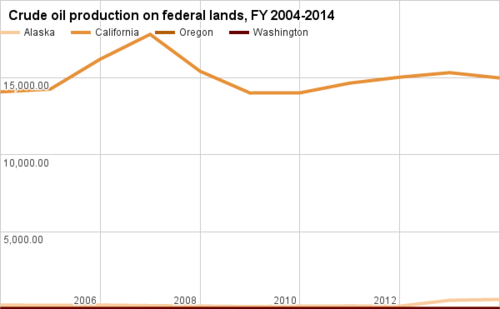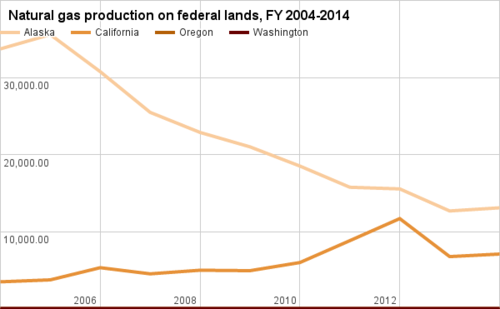Oil and gas production in Alaska
 From Ballotpedia - Reading time: 6 min
From Ballotpedia - Reading time: 6 min
![]() This article does not contain the most recently published data on this subject. If you would like to help our coverage grow, consider donating to Ballotpedia.
This article does not contain the most recently published data on this subject. If you would like to help our coverage grow, consider donating to Ballotpedia.
This article presents information about oil and gas production in Alaska. Sources for this information include the U.S. Energy Information Administration, the Office of Natural Resource Revenue, the U.S. Bureau of Land Management, and state-specific agencies and media sources.
Reserves[edit]
- See also: Fracking in Alaska
The maps below show crude oil and natural gas proven reserves by state in 2013 using data from the U.S. Energy Information Administration (EIA). Proven (or proved) reserves are defined by the EIA as "estimated volumes of hydrocarbon resources that analysis of geologic and engineering data demonstrates with reasonable certainty are recoverable under existing economic and operating conditions." This means that proven reserves can change over time as prices change and technological advances are made. For example, in 2013 there was an increase in the price of natural gas, making it economical to extract natural gas that previously had been too expensive to extract. This price increase led the EIA to increase its estimates of proven natural gas reserves.[1]
Oil and gas production on federal lands[edit]
The Office of Natural Resources Revenue (ONRR) provides data on mineral production on federal lands. The charts and tables below show federal onshore oil and/or natural gas production (in terms of the amounts sold) for fiscal years 2004 to 2014 for Alaska, its adjacent states (provided for comparison), and the United States as a whole.[2]
| Crude oil production on federal lands in Alaska and adjacent states, in thousands of barrels, fiscal years 2004 to 2014 | |||||||||||
|---|---|---|---|---|---|---|---|---|---|---|---|
| State | FY 2004 | FY 2005 | FY 2006 | FY 2007 | FY 2008 | FY 2009 | FY 2010 | FY 2011 | FY 2012 | FY 2013 | FY 2014 |
| Alaska | 233 | 211 | 230 | 194 | 163 | 131 | 159 | 170 | 158 | 539 | 594 |
| California | 14,064 | 14,243 | 16,187 | 17,799 | 15,403 | 13,993 | 13,999 | 14,634 | 15,016 | 15,311 | 14,967 |
| Oregon | 0 | 0 | 0 | 0 | 0 | 0 | 0 | 0 | 0 | 0 | 0 |
| Washington | 0 | 0 | 0 | 0 | 0 | 0 | 0 | 0 | 0 | 0 | 0 |
| U.S. total | 97,180 | 97,238 | 102,164 | 104,872 | 103,134 | 104,499 | 107,880 | 113,375 | 125,270 | 137,029 | 148,778 |
| Note: Oil includes black wax crude, condensate, drip or scrubber condensate, fuel oil inlet scrubber, oil, oil lost, other liquid hydrocarbons, sweet crude and yellow wax crude. These data are collected in terms of sale years, which are "transactions for sales that took place in a given fiscal year and do not include adjusted or corrected transactions for sales that took place in previous fiscal years."[3] Source: Office of Natural Resource Revenue, "Statistical Information" | |||||||||||
| Natural gas production on federal lands in Alaska and adjacent states, in MMCF, fiscal years 2004 to 2014 | |||||||||||
|---|---|---|---|---|---|---|---|---|---|---|---|
| State | FY 2004 | FY 2005 | FY 2006 | FY 2007 | FY 2008 | FY 2009 | FY 2010 | FY 2011 | FY 2012 | FY 2013 | FY 2014 |
| Alaska | 33,707 | 35,561 | 30,748 | 25,469 | 22,863 | 20,992 | 18,498 | 15,748 | 15,535 | 12,670 | 13,079 |
| California | 3,473 | 3,727 | 5,308 | 4,509 | 4,978 | 4,917 | 5,977 | 8,816 | 11,680 | 6,746 | 7,077 |
| Oregon | 0 | 0 | 0 | 0 | 0 | 0 | 0 | 0 | 0 | 0 | 0 |
| Washington | 0 | 0 | 0 | 0 | 0 | 0 | 0 | 0 | 0 | 0 | 0 |
| U.S. total | 2,403,287 | 2,580,017 | 2,660,419 | 2,891,765 | 3,081,528 | 3,196,500 | 3,033,285 | 2,918,572 | 2,906,698 | 2,655,876 | 2,499,870 |
| Note: Natural gas includes coalbed methane, flash gas, fuel gas, gas lost (flared or vented), nitrogen, processed (residue) gas, unprocessed (wet) gas and gas plant products. These data are collected in terms of sale years, which are "transactions for sales that took place in a given fiscal year and do not include adjusted or corrected transactions for sales that took place in previous fiscal years."[4] Source: Office of Natural Resource Revenue, "Statistical Information" | |||||||||||
Oil and gas wells[edit]
Oil and gas wells on federal lands[edit]
According to U.S. Bureau of Land Management, Alaska was home to 18,555 producing acres on federally held land in fiscal year 2014. See the table below for further details, including data from surrounding states.[5][6][7]
| Production related statistics for Alaska and adjacent neighboring states, fiscal year 2014 | |||||
|---|---|---|---|---|---|
| State | Producing acres | Permits approved | Wells spudded | Producing wells | Well completions |
| Alaska | 18,555 | 8 | 6 | 107 | 131 |
| California | 82,697 | 181 | 210 | 8,145 | 8,164 |
| Oregon | 0 | 0 | 0 | 0 | 0 |
| Washington | 0 | 0 | 0 | 0 | 0 |
| Note: "--" indicates data were not available. Sources: U.S. Bureau of Land Management, "Oil and Gas Statistics" U.S. Bureau of Land Management, "Mineral and Surface Acreage Managed by the BLM" U.S. Bureau of Land Management, "Public Land Statistics 2014" | |||||
Energy policy in the 50 states[edit]
Click on a state below to read more about that state's energy policy.
See also[edit]
Footnotes[edit]
- ↑ U.S. Energy Information Administration, "U.S. Crude Oil and Natural Gas Proved Reserves," December 19, 2014
- ↑ Office of Natural Resource Revenue, "Statistical Information," accessed October 11, 2015
- ↑ Office of Natural Resource Revenue, "ONRR’s Frequently Asked Questions – FAQs," accessed October 8, 2015
- ↑ Office of Natural Resource Revenue, "ONRR’s Frequently Asked Questions – FAQs," accessed October 8, 2015
- ↑ U.S. Bureau of Land Management, "Oil and Gas Statistics," accessed October 6, 2015
- ↑ U.S. Bureau of Land Management, "Mineral and Surface Acreage Managed by the BLM," accessed October 8, 2015
- ↑ U.S. Bureau of Land Management, "Public Land Statistics 2014," May 2015
| |||||||||||
 KSF
KSF





